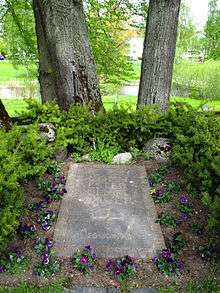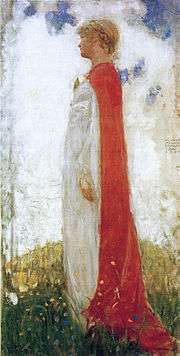Ester Ellqvist
| Ester Ellqvist | |
|---|---|
 Self-portrait, 1910 | |
| Born |
August 4, 1880 Ausås, Sweden |
| Died |
20 November 1918 (aged 38) Vättern, Sweden |
| Resting place | Jönköping, Sweden |
| Nationality | Swedish |
| Education | Royal Swedish Academy of Arts, Stockholm |
| Movement | Modernism |
| Spouse(s) | John Bauer |
Ester Ellqvist (sometimes spelled Esther Ellqvist) (4 August 1880 – 20 November 1918) was a Swedish artist, model and wife of John Bauer, who was a painter and illustrator. She studied at the Royal Swedish Academy of Arts and spent one year studying art in southern Germany and Italy with her husband. She died in 1918 with her husband and three-year-old son when the boat that they sailed on sunk, killing all 24 people on board.
Biography
Early life
Ruth Ester Elisabet Eliqvist was born on 4 August 1880 in Ausås, Skåne, daughter of teacher Karl Kristersson Eliqvist,[1] and raised in Stockholm. Ellqvist was a lively person who enjoyed the city's social life.[2][3]
Education
Ellqvist studied in the late 1890s at the Technical School (later known as Konstfack) in Stockholm,[4] to gain the skills that she need to gain acceptance at the Royal Swedish Academy of Arts. Her brothers Oscar and Ernst, who became photographers, and sister Gerda, who taught needlework, also attended the technical school.[5]
In 1900 her studies commenced at the Royal Swedish Academy of Arts.[4] The academy began accepting female students in 1864, but there was a different but not equal educational path for women. For instance, nude models were not used for female students.[6] During her time at the academy she also attended classes at the A. Tallbergs school for etchers.[7]
Ellqvist was an ambitious, skilled student during the early stages of the Modernist art movement,[6] and at the end of the National Romanticism period, which was represented in the works of[8] academy artists Carl Larsson, Anders Zorn, Bruno Liljefors and Richard Bergh. Ellqvist and her friends, were among the students of the academy who organized a protest against the conservative views of the school, which resulted in the creation of the influential Konstnärsförbundet (Artists Association).[6]
She graduated in 1905.[4]
Marriage
She met John Bauer at the Academy of Arts in 1900. They had periods of separation during which they sent each other letters exchanging their innermost desires and concerns.[9] She married Bauer on 18 December 1906. In the beginning of their relationship they were tender and happy with each other. There were times when they were unhappy, partially because they had different aspirations. Ellqvist wanted to live near Stockholm and her husband enjoyed being near the forest. She posed as model for many of his works, like Fairy Princess in which she appears to be an innocent, pure, and unattainable woman.[9] In 1908, financed by Bauer's father, they traveled through southern Germany and Italy for one year to study art.[10]
| ||||||
From left to right:
| ||||||
Ellqvist and Bauer had a son Bengt, who they called "Putte".[9] He was born in 1915.[11]
 |  | |
| Ester Ellqvist and John Bauer | Ester and her son, Putte | |
By 1917, their marriage was in trouble and their love for each other began to dwindle. Ellqvist had essentially given up her own artistic aspirations for her role as a wife.[12]
Death

Ellqvist, Bauer and their three-year-old son died on 20 November 1918 when the SS Per Brahe sailing to Stockholm sunk in Lake Vättern,[9][13] killing all 24 people (8 passengers and 16 crew members)[14] on board.[15] On 18 August 1922, the Bauers were buried at the Östra cemetery in Jönköping (in quarter 04 plot number 06).[16]
Career
Her self-portrait is the cover for Bakom maskerna: det dolda budskapet hos kvinnliga 1880-talsförfattare (Behind the masks: the hidden message in female 1880s writer).[17]
| ||||
From left to right:
| ||||
Popular culture
In 1986, Sveriges Television produced and broadcast the movie Ester—om John Bauers wife (Ester—About John Bauers Wife). Ester was played by Lena T. Hansson and John was portrayed by Per Mattsson. The movie was directed by Agneta Elers-Jarleman.[18]
References
- ↑ Romdahl, Axel L. "John Bauer". In Axelsson, Roger. Svenskt biografiskt lexikon (in Swedish). 2 (1920 ed.). Stockholm: National Archives of Sweden. p. 783. Retrieved 12 May 2014.
- ↑ Lindqvist, Gunnar (1979). John Bauer (in Swedish). Stockholm: Liber Förlag. pp. 32–34. ISBN 91-38-04605-9. Retrieved 20 June 2014.
- ↑ "John & Ester". www.jkpglm.se. Jönköpings Läns Museum. Retrieved 6 July 2014.
- 1 2 3 "Ester Ellquist". www.lexikonettamanda.se. Konstnärslexikonett amanda. Retrieved 3 September 2014.
- ↑ Ellers-Jarleman, Agneta (1995). Beck, Ingamaj; Waldenström, Barbro, eds. Dubbelporträtt: konstnärspar i seklets början [Double portraits: artists couples at the beginning of the century] (in Swedish). Stockholm: Natur och kultur. p. 79. ISBN 91-27-03819-X. Retrieved 6 September 2014.
- 1 2 3 "Konstakademien" [The Academy of Art] (in Swedish). Jönköpings Läns Museum. Retrieved August 31, 2014.
- ↑ Roosvall, Johnny; Lilja, Gösta, eds. (1953). Svenskt konstnärslexikon: tiotusen svenska konstnärers liv och verktrans_title=Swedish art lexicon: ten thousand Swedish artists and work (in Swedish) (2, Dahlbeck-Hagström ed.). Malmö: Allhem. Retrieved 6 September 2014.
- ↑ de Vries, Robert. "Nationalromantiken". www.so-rummet.se. SO-rummet. Retrieved 6 September 2014.
- 1 2 3 4 "John & Ester" (in Swedish). Jönköpings Läns Museum. Retrieved August 31, 2014.
- ↑ Lindqvist, Gunnar (1979). John Bauer (in Swedish). Stockholm: Liber Förlag. pp. 38–39. ISBN 91-38-04605-9. Retrieved 20 June 2014.
- ↑ Schiller, Harald (1935). John Bauer, sagotecknaren [John Bauer, the fairy tale illustrator]. Sveriges allmänna konstförenings publikation (in Swedish). Stockholm: Sveriges allmänna konstförening. p. 194. Retrieved 6 September 2014.
- ↑ Corin, Claes (2013). I John Bauers fotspår [In the footstep's of John Bauer] (in Swedish). Laholm: Corzima. p. 44. ISBN 978-91-637-3020-7. Retrieved 20 June 2014.
- ↑ "John Bauer – A biography". Jönköpings Läns Museum. Retrieved August 31, 2014.
- ↑ Andersson, Mats. "Ett dyk vid Per Brahes förlisningsplats 1989" [Diving where Per Brahe sunk] (PDF). www.matsandersson.nu. Mats Andersson. Retrieved 6 September 2014.
- ↑ Scandinavian Review. American Scandinavian Foundation. 1983. p. 43.
- ↑ "Historiska och kända personer begravda på Östra kyrkogården" [Historical and famous people buried at the East Cemitary]. www.svenskakyrkanjonkoping.se. Svenska kyrkan Jönköping. Retrieved 23 June 2014.
- ↑ Bakom maskerna: det dolda budskapet hos kvinnliga 1880-talsförfattare [Behind the masks: the hidden message in female 1880s writers] (in Swedish). Högskolan i Karlstad. 1 January 1997. ISBN 978-91-630-5234-7.
- ↑ "Ester – om John Bauers hustru (1986)" [Ester – about John Bauers wife (1986)]. www.sfi.se. Swedish Film Institute. Retrieved 21 June 2014.
Further reading
- Agrenius, Helen (1996). Om konstnären John Bauer och hans värld [About the artist and his world] (in Swedish). Jönköping: Jönköpings läns museum. ISBN 91-85692-29-8. Retrieved 20 June 2014.
- Agrenius, Helen; Jackson, Charlotte (1996). The artist John Bauer and his world. Jönköping: Jönköping County Museum. ISBN 91-85692-30-1. Retrieved 23 June 2014.
- Lindqvist, Gunnar (1991). John och Ester, makarna Bauers konst och liv [John and Ester, life and art of the Bauer's] (in Swedish). Stockholm: Carlsson. ISBN 91-7798-458-7. Retrieved 23 June 2014.
- Sweden Now. Ingenjörsförlaget. 1982. p. 44.
External links
![]() Media related to Ester Ellqvist at Wikimedia Commons
Media related to Ester Ellqvist at Wikimedia Commons




